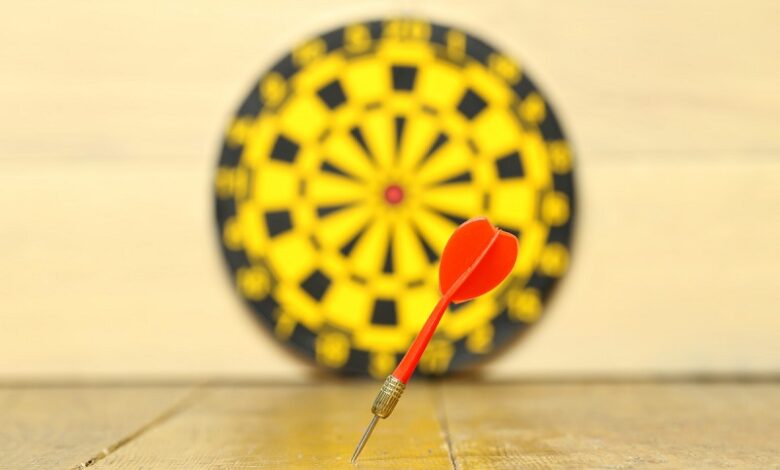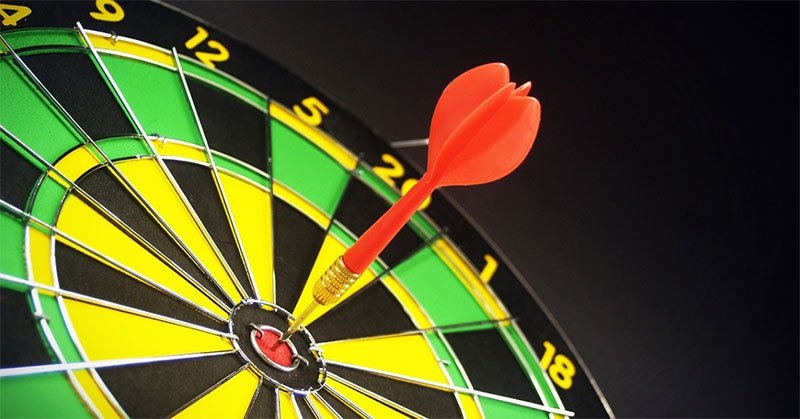
Darts is more than just a pub game. It’s a precision sport that requires the right equipment to excel. Choosing the perfect set of darts can make a significant difference in your game. In this guide, we’ll walk you through the various types of darts available, helping you find the ideal set to elevate your dart-throwing experience.
Understanding Dart Components
Before delving into the types of darts, it’s essential to familiarize yourself with their key components:
- Barrel: This is the main part of the dart that you grip and throw.
- Shaft: The shaft connects the barrel to the flight. It comes in various materials, including plastic, nylon, and aluminum.
- Flight: The flight is the fin-shaped piece at the back of the dart. It helps stabilize the dart’s trajectory.
- Point: This is the tip of the dart that sticks into the dartboard. Points can be made of steel, plastic, or soft tip for electronic dartboards.
Types of Darts
Steel Tip Darts:
Material: These darts have a steel tip, making them suitable for traditional sisal dartboards.
Weight: Steel tip darts typically range from 18 to 30 grams.
Grip Style: They come in various grip styles, including knurled, ringed, and smooth.
Advantages: Steel tip darts are durable and provide a satisfying thud when hitting the board.
Soft Tip Darts:
Material: Soft tip darts have, as the name suggests, a softer, plastic tip. They’re used with electronic dartboards.
Weight: They are generally lighter, ranging from 12 to 20 grams.
Grip Style: Soft tip darts often have a knurled or ribbed grip.
Advantages: They’re safer for younger players and are a must for electronic dartboard enthusiasts.
Tungsten Darts:
Material: Tungsten is a dense, heavy metal used in premium darts. Higher tungsten percentages mean slimmer barrels for tighter groupings.
Weight: Tungsten darts come in a range of weights, but even lighter tungsten darts can be as effective as heavier ones made of other materials.
Grip Style: Tungsten darts offer various grip styles to suit different preferences.
Brass Darts:
Material: Brass darts are made of, well, brass. They’re an excellent choice for beginners or those on a budget.
Weight: They come in a wide range of weights to cater to different playing styles.
Grip Style: Brass darts often feature a knurled or grooved grip for better control.
Nickel-Silver Darts:
Material: Nickel-silver is a durable alloy often used in mid-range darts.
Weight: They offer a variety of weights to cater to different players’ preferences.
Grip Style: Nickel-silver darts can have a range of grip styles, from knurled to smooth.
Choosing the Right Dart for You
Selecting the perfect dart depends on your individual playing style, budget, and personal preferences. Consider factors like grip style, weight, and material. It’s also a good idea to try out different darts to see which ones feel most comfortable in your hand.
Caring for Your Dart Set: Maintenance Tips
Now that you’ve chosen the perfect set of darts, it’s important to take proper care of them to ensure they stay in prime condition. Here are some maintenance tips to keep your darts performing at their best:
- Regularly Check and Tighten Flights and Shafts: Over time, flights and shafts can become loose. Check them before each game and tighten them as needed to prevent wobbling during throws.
- Keep Your Darts Clean: Use a soft cloth to wipe off any dirt or residue from your darts after each use. This helps maintain their appearance and grip.
- Avoid Dropping Your Darts: Dropping your darts, especially on hard surfaces, can damage the tips and barrels. Handle them with care to prevent unnecessary wear and tear.
- Rotate Your Darts: If you play frequently, consider rotating your darts to distribute the wear evenly. This can help extend the lifespan of your favorite set.
- Store Your Darts Properly: When not in use, store your darts in a protective case or a dart wallet. This helps prevent them from getting scratched or damaged.
- Replace Worn Components: Keep an eye on the condition of your flights, shafts, and tips. When they start showing signs of wear, it’s time to replace them to maintain optimal performance.
The Art of Dart Selection: Finding Your Perfect Set
Selecting the right set of darts is akin to choosing the perfect tool for a craft. It’s a personal decision that can greatly impact your performance and enjoyment of the game. Whether you’re a seasoned player or just starting out, experimenting with different dart types can lead you to discover the set that feels like an extension of your own hand.
So, the next time you step up to the oche, armed with your chosen darts, remember that you’re wielding more than just a piece of metal. You’re wielding precision, skill, and the potential for victory.
FAQs
Q: What’s the best weight for a dart?
A: The best weight for a dart depends on personal preference. Some players prefer heavier darts for stability, while others opt for lighter ones for more control.
Q: Can I use steel tip darts on an electronic dartboard?
A: It’s not recommended, as steel tip darts can damage the electronic sensors. Stick to soft tip darts for electronic boards.
Q: How often should I replace my dart flights?
A: This depends on how frequently you play. If you notice signs of wear and tear, such as bent or torn flights, it’s time for a replacement.
Q: What’s the difference between tungsten and brass darts?
A: Tungsten darts are denser, allowing for slimmer barrels and tighter groupings. Brass darts are more budget-friendly and a great choice for beginners.
Q: Can I customize my darts?
A: Yes, many manufacturers offer customization options for barrels, shafts, and flights, allowing you to create a set that suits your style.
Choosing the right set of darts is a crucial step towards becoming a skilled player. Consider your preferences and budget, and don’t be afraid to try out different types to find the perfect fit for your game.


